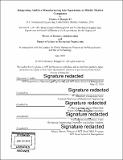| dc.contributor.advisor | John Hart and John F. Carrier. | en_US |
| dc.contributor.author | Mangan, Thomas J.(Thomas James),IV | en_US |
| dc.contributor.other | Sloan School of Management. | en_US |
| dc.contributor.other | Massachusetts Institute of Technology. Department of Mechanical Engineering. | en_US |
| dc.contributor.other | Leaders for Global Operations Program. | en_US |
| dc.date.accessioned | 2019-10-11T22:24:09Z | |
| dc.date.available | 2019-10-11T22:24:09Z | |
| dc.date.copyright | 2019 | en_US |
| dc.date.issued | 2019 | en_US |
| dc.date.issued | 2019 | en_US |
| dc.identifier.uri | https://hdl.handle.net/1721.1/122572 | |
| dc.description | Thesis: M.B.A., Massachusetts Institute of Technology, Sloan School of Management, 2019, In conjunction with the Leaders for Global Operations Program at MIT | en_US |
| dc.description | Thesis: S.M., Massachusetts Institute of Technology, Department of Mechanical Engineering, 2019, In conjunction with the Leaders for Global Operations Program at MIT | en_US |
| dc.description | Cataloged from PDF version of thesis. | en_US |
| dc.description | Includes bibliographical references (pages 60-61). | en_US |
| dc.description.abstract | Ascent Aerospace's leadership recognizes the transformative potential of additive manufacturing (AM) to the aerospace tooling industry. As a middle market company, Ascent required a deliberate approach to identifying areas with the highest potential for value creation. Without the research and development budget of an aerospace OEM, the best path forward for Ascent is to leverage existing AM technologies and those requiring minimal further development. The motivation for this project is to identify the best path forward for Ascent in leveraging AM as a value creation tool. Ascent had no AM capability at the beginning of this project, using a supplier when AM components when specifically requested by a customer. The thesis describes a methodology and results for identifying where to integrate AM into operations. It discusses the data and analysis used to find impact areas. The thesis also addresses some of the barriers impacting the adoption of AM. The analytical methods and organizational factors for additive adoption provide a holistic view of how to integrate AM into regular operations. Abstracted away from the case studies, the method should be actionable at any capitally constrained company to generate value through the adoption of AM. Recommendations on future work on how to approach the adoption of AM will be discussed, along with specific future work related to the thesis. | en_US |
| dc.description.statementofresponsibility | by Thomas J. Mangan, IV. | en_US |
| dc.format.extent | 61 pages | en_US |
| dc.language.iso | eng | en_US |
| dc.publisher | Massachusetts Institute of Technology | en_US |
| dc.rights | MIT theses are protected by copyright. They may be viewed, downloaded, or printed from this source but further reproduction or distribution in any format is prohibited without written permission. | en_US |
| dc.rights.uri | http://dspace.mit.edu/handle/1721.1/7582 | en_US |
| dc.subject | Sloan School of Management. | en_US |
| dc.subject | Mechanical Engineering. | en_US |
| dc.subject | Leaders for Global Operations Program. | en_US |
| dc.title | Integrating additive manufacturing into operations at middle market companies | en_US |
| dc.type | Thesis | en_US |
| dc.description.degree | M.B.A. | en_US |
| dc.description.degree | S.M. | en_US |
| dc.contributor.department | Sloan School of Management | en_US |
| dc.contributor.department | Massachusetts Institute of Technology. Department of Mechanical Engineering | en_US |
| dc.contributor.department | Leaders for Global Operations Program | en_US |
| dc.identifier.oclc | 1119387897 | en_US |
| dc.description.collection | M.B.A. Massachusetts Institute of Technology, Sloan School of Management | en_US |
| dc.description.collection | S.M. Massachusetts Institute of Technology, Department of Mechanical Engineering | en_US |
| dspace.imported | 2019-10-11T22:24:08Z | en_US |
| mit.thesis.degree | Master | en_US |
| mit.thesis.department | Sloan | en_US |
| mit.thesis.department | MechE | en_US |
